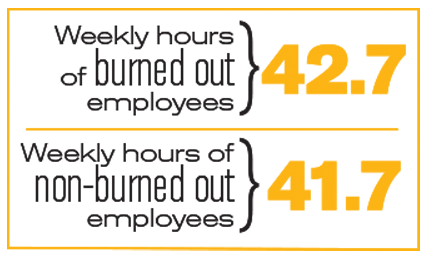Inspiring engagement | a data-driven report on motivating, recognizing and retaining employees
Mar 11, 2021
Written by: BI WORLDWIDE's Research and Strategy Team
(View Author Bio)
Employees are motivated to work harder when they find meaning in their work. To create positive experiences for your customers, create meaningful ones for your employees. Employees should experience these as part of the First Day experience and each day thereafter. Here's how.
Scroll Down
Introduction
At BI WORLDWIDE, we study employees. In other words, we study people. What motivates them. What engages them. What earns their trust and loyalty. What inspires them to give their best. The result is a collection of data we call the New Rules of Engagement study.
In reviewing this past year’s study – the source of much of what you’ll find here – we identified some clear themes. Unsurprisingly, some reflect new outgrowths of old truths because they are the core of a great work experience. People appreciate recognition and value meaningful work. They want to be heard. They want a path forward.
But others are clear shifts in what today’s workers value. Diversity, equity and inclusion have become central to both culture and business results. Work culture can impact your employees’ physical health. Engagement strategies are likely impacting your customer satisfaction.
We are also careful to study the complete employee experience. We think about how we can positively impact employees on all the moments that count. From Decision Day, when they first hear about the job, to their First Day, to the Every Day culture, to recognizing them on Achievement Day and ensuring they become advocates on Referral Day. You’ll see these moments captured and mentioned throughout this report.

One final note: It’s important to recognize this study was conducted during a period of stable work circumstances. There were no extenuating factors such as economic uncertainty or a global health crisis. We believe these topics are still relevant in this new world of work. The way we put solutions in place may differ, but the fundamental drivers of the work experience remain largely the same.
Promoting diversity, equity and inclusion comes down to recognizing your team's humanity.
And your own.
The current state of diversity, equity and inclusion is simple: there is huge opportunity for growth.
Many findings affirm that we can do better. But just one might suffice: there are fewer Fortune 500 CEOs who are women (4.1%) than who are named David (4.5%) or John (5.3%). (NY Times)
In case that weren’t enough, as of June 2020, only four Fortune 500 companies have African American CEOs. (CDC, Diversity Inc.) 40% of people think there’s a double-standard against hiring women – that both men and women are more likely to hire men over women. (Pew) Men are 30% more likely than women to be promoted from entry level to manager. (Women in the Workplace) And resumes submitted by people with “African American-sounding names” are 14% less likely to get a call back than those with “white-sounding names”. (Research study by University of Wisconsin)
We not only need to be conscious of the current state of work but also the current state of ourselves. We now see the limitations of our statements, thoughts and actions of ten years ago. We will say things today – including in this report — which we will see differently in 10 years. Growth means accepting this, remaining open minded and doing our best.
A growing body of evidence suggests the pursuit of a workplace which is more inclusive, equitable and fair is definitely worth it. We see positive impacts on the Every Day experience of employees as well as on the business results.
•Included employees are 17 times more likely to say working brings out their best ideas. (BI WORLDWIDE)
• Organizations with the highest ethnic diversity are 35% more likely than the lowest to have above typical financial performance. (McKinsey)
• Diverse companies have 2.3 times higher cash flow per employee over a three-year period. (Bersin by Deloitte)
•Included employees are 6 times more likely to work as hard as they can. (BI WORLDWIDE)
• For every 1% rise in the rate of gender diversity, there is a 3-9% rise in sales. (The Financial Times)
True diversity is hard to achieve. Of course, diversity in hiring is a starting point. Decision Day considerations should include how to attract people of diverse backgrounds to your organization. A group of people from different backgrounds, genders, religions, socio-economic statuses, educations and ways of thinking are going to create more new and different ideas than a group of people that is homogeneous.
But true diversity also means allowing people to bring their whole selves to work. If we hire people who are unlike us and then demand that they be like us, to fit the mold of the company or culture or team we’re building, we do not truly have diversity. We have conformity with some cosmetic differences. And true diversity is better for business.
We can achieve true diversity by creating equitable and inclusive work environments. We recently asked employees to complete the sentence, “I would have more opportunity at my organization if I were…” and listed characteristics such as a different gender, race or ethnicity, religion, gender identity, sexual orientation and whether or not they have children. If an employee said “yes” to any one of these, we coded them as feeling inequity at work.
Those who felt inequity were 4 times more likely to wish they were working someplace else and 37% of them plan to leave their organizations in the next 12 months. They also were 7 times more likely to be harassed at work (any type of harassment, not just sexual harassment) and 4 times more likely to report that harassment. Clearly, there are costs associated with inequity in the form of both turnover and risk management.
Behavioral economics is working against us.
It may seem hard to create a diverse, equitable and inclusive culture, and it is. But addressing these innate biases head on will help tremendously.
1. Unconscious bias. We unconsciously use mental shortcuts. Being aware of these shortcuts, and checking our decision-making to be sure we are being fair, can counteract this problem.
2. Similarity preference. We naturally prefer people like us. It takes intentional effort to seek out and build relationships with people who are different from us.
3. Confirmation bias. We seek to reinforce what we already believe. This makes us less open-minded to new, innovative ideas.
4. Conformity. It is hard to go against the group. We should respect people who speak up and ensure their ideas get a fair hearing – even if we don’t always adopt them.
On the flip side, those employees who feel included are 15 times more likely to find work inspiring than those who do not feel included. This inspiration can lead to greater productivity and innovation. 77% of them would recommend their organizations as great places to work. (See page 17, about the power of referrals.)
True equity and inclusion need to be ingrained in your culture. That takes time. Ask yourself: Would your employees affirm the statements below? And can you answer yes to them as well?
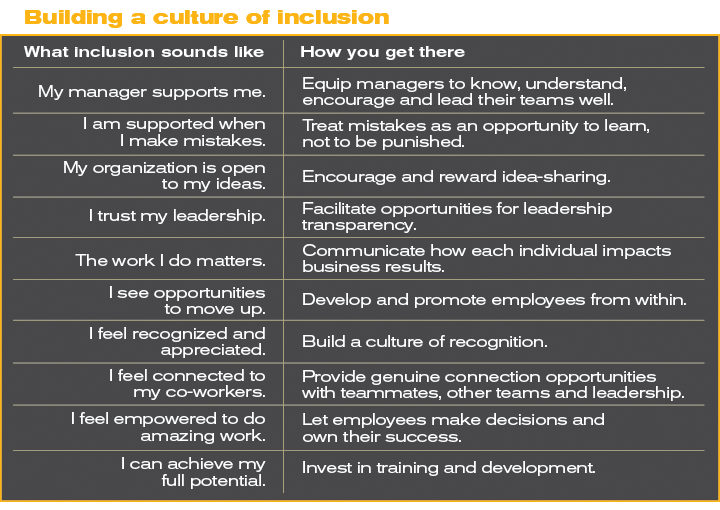
Once this culture is built, we need to protect it. Creating a strong speak-up culture, sometimes called psychological safety, will help people feel included at work while reinforcing a culture of inclusion. To learn more about creating a speak-up culture, see Appendix B.
The benefits of a healthy work culture? They may be greater than you think.
Do workplace culture and engagement help contribute to improved employee health? We’re convinced of it. The Every Day experience at work is increasingly linked to our everyday personal lives and wellbeing. But let’s start with the hard numbers – and the vast impact small changes to employee health could have on your business.
According to the Kaiser Family Foundation, the average yearly premium for family healthcare coverage in the United States rose over $20,000 for the first time in 2019 (71% of which is paid for by the employer).
So let’s assume your healthcare premiums are $10,000 a year per employee, you have 10,000 employees and you pay 71% of that cost. If you could reduce healthcare costs by just 5%, you’d save $3.6 million a year.
One of the most promising ways to reduce those costs is also the simplest: there is a strong link between having a healthy workplace culture and employee health. What if you expanded your wellness programs to include employee engagement practices?
Consider burnout – an extreme form of disengagement. Contrary to what you might expect, burned out employees are not putting in significantly more time than their less burned out peers. They put in an average of 42.7 hours a week, a single hour more than non-burned out employees.
Feeling burned out is like being on a spinning wheel but going nowhere. It’s not caused by pedaling too hard – it’s caused by not getting anywhere when you do.
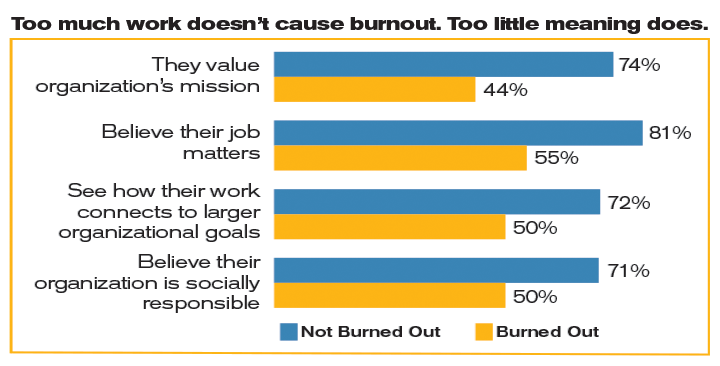
The good news: it’s surprisingly easy to gain some traction. In a healthy workplace culture, people feel like their job matters and see how it connects to larger organizational goals. They also believe their company is socially responsible and value its mission. Not only will they be happier, they are also twice as likely to recommend their organization as a great place to work.
Employees who report being in a healthy workplace are also at least twice as likely to feel:
• Their manager understands them
• Their ideas are taken seriously
• Confident the good work they do will be recognized
• Their job challenges them to push their limits
Encouraging leaders to manage their teams by listening, challenging, empowering and recognizing doesn’t simply engage employees, it also attracts them. And beyond the cost of unhealthy employees, that’s a powerful reason to invest in a healthier workplace. As the costs of an unhealthy workforce rise, it’s more important than ever to fix the issues in workplace culture that contribute to poor health.
It's hard to do recognition wrong. It's easy to do it better.
__________
Formal recognition programs have been around long enough for organizations to know recognition plays an important role in engaging employees not just on Achievement Day but also in the Every Day experience. But many struggle with the specifics of implementation and often overlook things that can have a major impact on the outcomes of a program.
__________
What does an organization need to do in order to keep up its end of the bargain? Is it enough to recognize top performers at a team or company meeting? Should they supplement recognition with monetary rewards? Are they recognizing employees enough? Or too much?
Over our years of research and client work, we have found that:
• Even simple types of recognition are beneficial.
• Being specific, personal and associating the recognition message with a desired behavior or business outcome is particularly meaningful to a recipient.
• Over time, recognition can be made even more powerful if your managers learn employee preferences for private vs. public recognition, the types of behaviors they want to be recognized for (individual or team contributions, values or metrics) and their favorite types of rewards. For example, length-of-service awards are particularly meaningful to some teams. Achievement or performance awards matter more to others.
• We have not seen a single example of meaningful recognition provided too often.
We also know recognition is best when it is accompanied by a reward, delivered in writing and explains how the recipient made a difference in some way. As shown below, individuals who received such recognition showed the greatest intent to stay and work hard for their organizations.
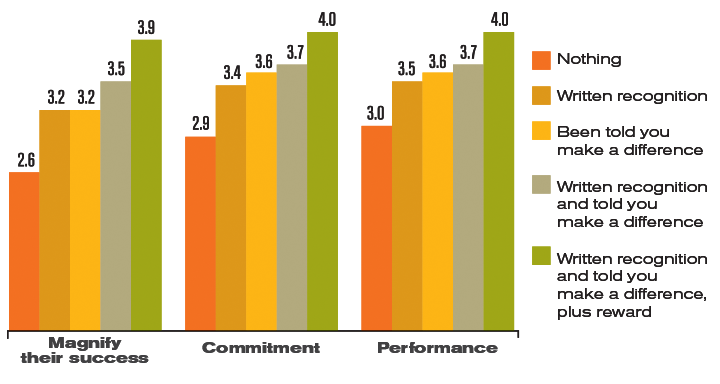
When considering which type of reward to pair with a recognition message, some rewards are a little more rewarding. As reflected in the Extrinsic Rewards Efficacy Continuum developed by Dr. Ran Kivetz, Ph.D. at Columbia Business School, hedonic rewards such as tangible merchandise or experiences are more motivating and produce better results than cash or cash-equivalent rewards like gift cards.
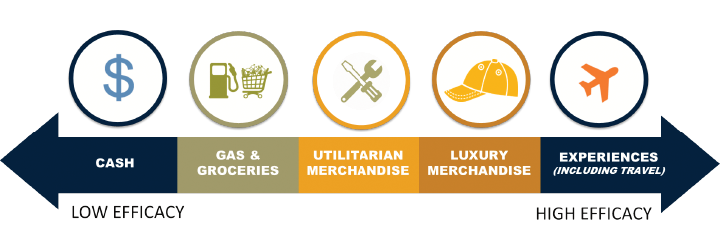
Research has also shown:
• Hedonic rewards are especially effective when they can be customized to individual preferences. (Incentive Research Foundation)
• Experiences and travel are the most effective type of hedonic reward. According to a study conducted by Expedia and The Center for Generational Kinetics, 74% of Americans prioritize experiences over products or things.
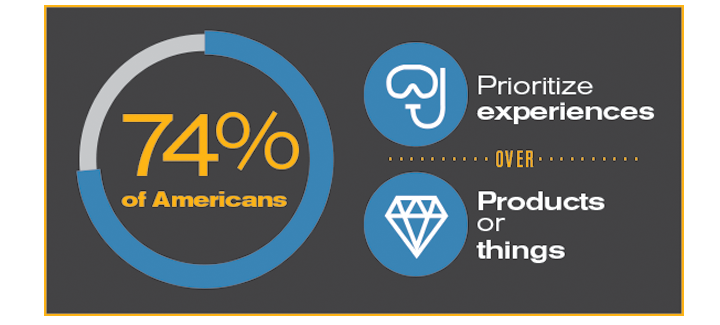
But is recognition really driving higher performance? Or simply affirming those who are already overperforming?
A study we conducted with salespeople suggests that recognition does indeed drive performance. Salespeople were asked questions prior to the start of an incentive period, including “Have you received incredible recognition at work?” We knew their sales history, which provided a baseline, and then measured how they performed during the incentive. Salespeople who had experienced incredible recognition in the past were more likely to see a lift during the incentive period, regardless of their previous performance.
Your organization’s highest performers will undoubtedly receive more recognition, as they should. However, that recognition will continue to prompt them to even greater performance – and will encourage those not in the top tier to elevate their performance as well.
Hedonic rewards vs. cash rewards | Is it all about the cost-value of the reward, with more expensive items being more effective?
A BIW analysis of data from one customer’s organization examined the efficacy of different reward types. Managers recognized a group of employees over a period of time with two types of rewards:
1. Debit cards loaded with cash
2. Points that could be redeemed for a range of rewards, from low-cost music downloads to luxury vacations
On average, employees earned more than $100/month on their debit cards and less than $100/month in points — eliminating the objection that points-based rewards might perform better simply because they’re worth more. Both types of rewards could be saved or spent immediately, be used for a wide range of high-value and low-value options and had monetary value.
In practice, participants’ spending habits were very different:
• More than 85% of employees saved their points for luxury items like merchandise, travel or experiences.
• They spent their debit cards regularly at vending machines, fast food restaurants and gas stations, with nearly 85% of transactions under $30.
The results were also different:
• Employees who earned points outperformed those who earned cash, experiencing on average a 43% unit increase over their baseline performance.
• Employees who earned cash experienced a 16% decrease in performance.
__________
The bottom line: Cash disappears into day-to-day necessities. Points inspire dreams – and the type of performance that moves your business forward.
__________
To get employees to perform in the present, show them their FUTURE.
Many elements of the Every Day experience impact engagement. In our nationally-representative research though, only one element of work lands in the top three for predicting commitment and performance: a sense of a promising future at an organization.

Other elements of the work experience may be a top predictor of commitment, or performance, but not both. Only a sense of a future can do that. When employees feel as if their current organization presents a promising long-term opportunity, they respond by not only committing to that organization but also working harder on a daily basis. An employee should be able to see their own career path at an organization as well as the path the organization will take.
Career pathing, coupled with communication from leadership about the direction of the organization, can greatly improve both the commitment and performance of employees at an organization. Ultimately, this is a crucial step in managing a workforce and providing an experience that will foster employee engagement. By treating employees like humans, their experience improves, as well as the health of the overall organization.
When you ask employees where they want to be in five years, take their answers seriously. Show them a path to get there and they may get there with you — exceeding expectations and delivering value.
Nothing drives customer satisfaction like employee experience.
The positive effects of employee experience on customer satisfaction are often overlooked or understated.
Of course, our focus as a business is naturally on customers. We all understand that without them, we wouldn’t have employees (or a company — or a job). But we can’t forget that engaged employees are loyal employees. They stick around longer so they develop knowledge and skills that become hard to replace.
__________
Without engaged employees that care about the customer experience, those customers eventually disappear.
__________
Employees are motivated to work harder when they find meaning in their work. Nothing else has such an effect. 94% of employees who find meaning in their work are willing to work hard for their customer — as opposed to only 57% of employees who don’t find meaning in their work.
To create positive experiences for your customers, create meaningful ones for your employees. Employees should experience these as part of the First Day experience and each day thereafter. Here’s how:
• Validate your organization’s mission. First, make sure you have a mission. Then, communicate about why that mission matters. What difference does it make in the world? Why should employees care?
• Make sure employees know how their work connects to larger organizational goals. Define those larger goals (which should be connected to the mission) and communicate how each employee’s work impacts them, whether that is through manager or organizational communication (ideally both).
When it comes to hiring, referrals are your secret weapon.
How many of your top employees were referred to your company by someone who already worked for you? Many hiring teams are not tapping into the best source of recruiters – their own employees. Whether you are dealing with reduced budgets for hiring, finding a select few hires after recent layoffs or a sudden need to hire a lot of people, your existing employees can help you find the best candidates.
We’ve found employees who refer others to you are more engaged than those who don’t. But that’s not all that surprising. What’s even more compelling is the employees they refer are also more engaged. And the benefits don’t stop there.

Employees referred by a friend or family member tend to be more engaged, more committed, better performing and happier at work.
So how do you make sure your employees approach Referral Day ready to refer? Formal referral programs that offer an incentive work well. There are also certain aspects of culture and work experience that actually predict what makes employees more likely to recommend their company as a great place to work. In our research, employees are more likely to refer others to their organization if they feel:
• Empowered. No matter what their position is, give employees the chance to lead, take their ideas seriously and trust them with important decisions.
• A sense of accomplishment. Challenge your employees to push the limits of what they can achieve. When they go home at the end of the day, they should feel proud of the work they have done.
• A sense of belonging. Ensure that employees feel your organization is a place for people like them. This starts with being open to their contributions and ideas.
__________
When employees feel empowered, challenged and as if they’re in an open-minded organization, they’ll be eager to refer others they think may be a good culture fit. You’ll recruit more of the best talent – and instead of utilizing resources to go get them, they’ll come to you.
__________
BI WORLDWIDE U.S. Benchmark Survey Methodology
BI WORLDWIDE partnered with a United States panel company to target U.S. employees of companies with 500 employees or more. In addition, BI WORLDWIDE recruited U.S. employees of companies with 500 employees or more on a social media site. The online survey was available from January 23, 2019 to February 4, 2019. A total of 1,182 records were kept after data quality procedures removed respondents who completed too quickly or with suspicious response patterns; 474 respondents came from the social media site while 708 respondents came from the panel company. The typical respondent took 9.77 minutes to complete the survey.
__________
Representative proportions of demographics such as gender, age and race were targeted so that the final sample of respondents accurately reflected the demographics of those in the U.S. workforce.
__________
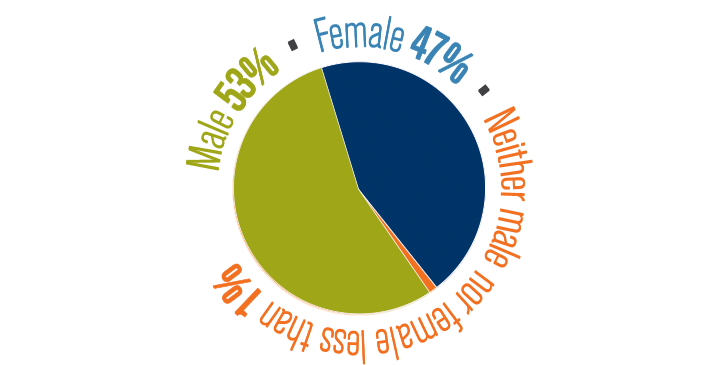
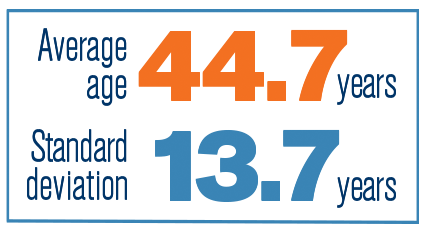
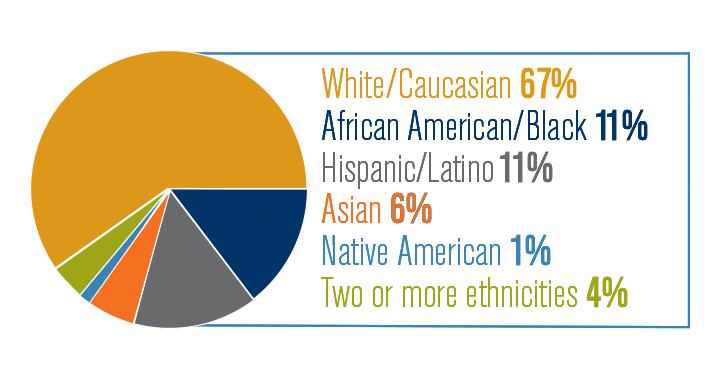
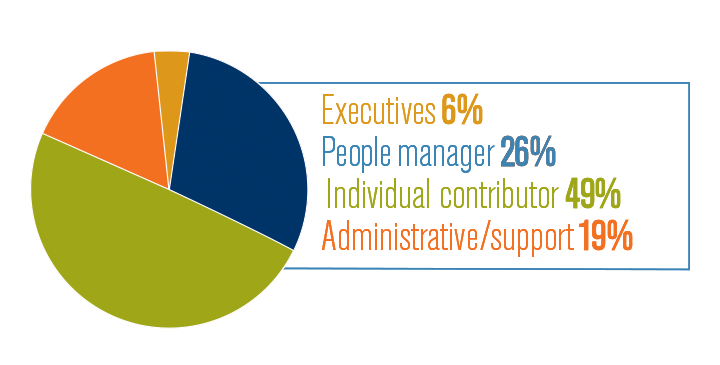
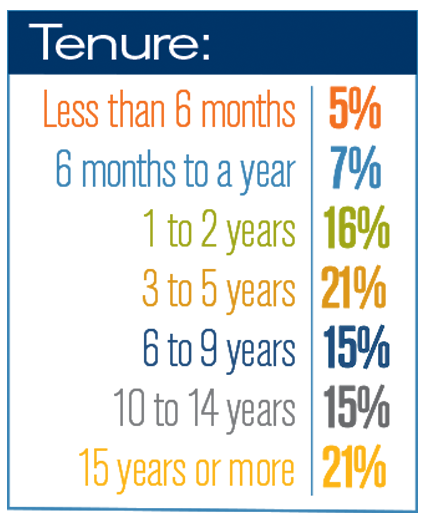

Appendix A: STEM & gender diversity
In order to create a diverse workforce, you need to be sure your organization’s employee value proposition is appealing to a broad group of people. If the EVP is attractive only to a specific group, you should not be surprised when that’s the group you see applying, accepting positions and staying.
Many companies are struggling with gender diversity in STEM fields (defined here as jobs that require: Computer Science, Engineering, Math/Statistics, Natural Sciences and Physical Sciences). There are fewer women than men doing the work and in many STEM fields, attrition among women is higher than attrition among men.
So how can organizations attract - and keep - highly talented women in STEM?
One place to start is by understanding whether people in STEM are motivated by the same employee value proposition as people in non-STEM fields. In our research, we found the top two drivers of commitment and performance among non-STEM employees in the United States were a sense of accomplishment and meaning at work.
While those two areas are key drivers for employees across the board, we found that STEM employees placed higher value on things like:
• Recognition
• Career advancement
• Teamwork
• Being an innovative, open-minded place to work
Our research supports the idea that companies looking to attract STEM employees should advertise how they recognize and advance talent in a cool, collaborative environment.
In addition to what motivates STEM employees, it’s also important to understand how to reach a diverse group of STEM employees. A company looking to attract women in STEM needs to be thoughtful about not creating a culture that appeals primarily to men. While not all men and women are the same, we can look at what broadly motivates these gender groups to make sure the culture a company creates is not excluding a particular group.
When comparing the drivers of men and women within the STEM field, we found the most important areas for men were career pathing, meaning and recognition. While women valued these things as well, the most important areas for them were collaboration, accomplishment and an innovative, open-minded place to work.
__________
An organization that wants to become more diverse should take steps to understand what audiences they’re seeking to attract, including what those groups are looking to get out of work, and provide an employee value proposition that appeals broadly to those groups.
__________
Appendix B: How to create a speak-up culture
Speaking up is hard. In 1951, Solomon Asch told a group of people they would be participating in a visual perception test. One of the individuals was an actual study participant and the rest were in on the experiment. They had no relationship to each other and no power dynamics. The participant was asked an objective, easy question: which line (A, B, or C) equaled the reference line, as pictured in Figure 1.
__________
People will follow the opinion of the group even when the group is clearly wrong.
__________
The participants who were in on the experiment sometimes insisted an obviously too short or long line was the reference line. If the group stated the wrong answer, so would the participant.
(If you’re curious, here’s a video of one participant.)
__________
If we cannot go against the group when evaluating the length of a line, how do we expect employees to speak up at work – with its complicated relationships, built-in power dynamics at play and difficult and subjective tasks?
__________
We have found four ways to make speaking up more likely:
1. Instill confidence by training. While some confidence is inborn, people who said they received the training they need to do their jobs well in the past year were more likely to say they would voice their opinions at work, even if they were unpopular.
2. Let them lead. People who lead projects, initiatives or teams, or who have just been heard and taken seriously before, are more likely to speak up in the future.
3. Give it meaning. Speaking up is often uncomfortable and comes with some social risk. While we can do our best to reduce that social risk in our organizations through culture, we can also make it more likely for people to speak up if we ensure they really believe in what they are doing. People are more willing to protect something that is extremely valuable to them.
4. Improve belonging and support. Speaking up is far less scary if you know you are in a safe space and have a strong team behind you. Those who feel like they have the support of their team members and belong to that team are more likely to voice their opinions.
Ready to engage?

